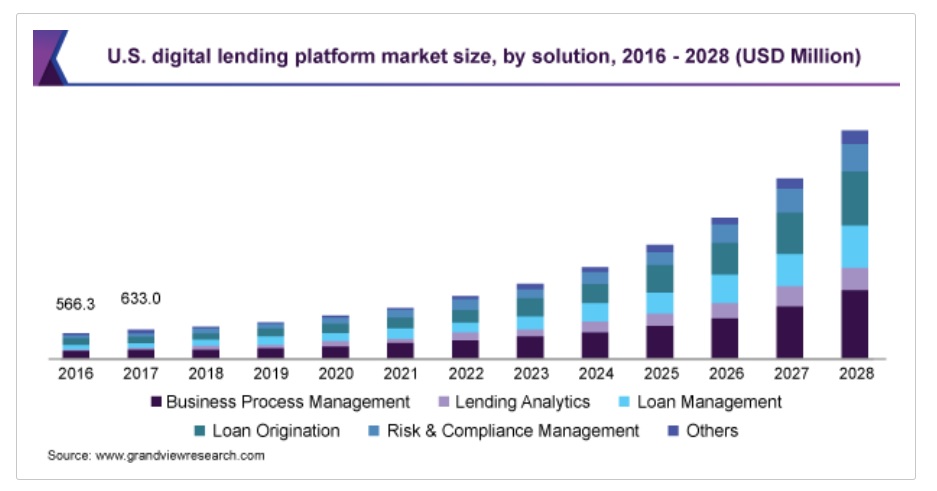
Digital lending has evolved over the last ten years and the pandemic has only exacerbated the need for intuitive, enjoyable, dynamic, and accessible lending systems for both lenders and borrowers. In the age of Apple and Amazon, borrowers demand a seamless experience that does not involve speaking to a human being or filling out paper forms.
While traditional banks and monoline lenders are overhauling their systems to address these challenges, FinTech companies are making use of the gaps left by the big banks.
The Era of Digital Lending
According to the Canada Banker’s Association, 49% of Canadians do their banking digitally, but more importantly, 75% of Canadians intend to maintain the digital banking habits they picked up during the pandemic. Compared to five years ago, FinTech companies in the US today account for more than 38% of the personal loan space. Traditional banks, on the other hand, saw a loss of 12% of the personal loan space during the same period.
Why is this? The reason is a lack of simplicity, speed, and accessibility.
Leading FinTechs today can provide multiple quotes within minutes and fund loans within a matter of day. Apart from speed, online lenders today offer a seamless, fully digital experience as well as advanced features including security and risk assessment that does not involve a long-drawn-out credit check process.

Digital Lending Challenges Faced by Lenders Today
Creating a fully automated, digital-first lending solution can be a complex process, especially if you don’t have the right tools and automation in place.
Automated self-service, compliance, fraud and cyber-security, document processing are just some of the many challenges that traditional financial institutions must overcome to match the experience offered by FinTechs today.
Here is our point of view on some of these key challenges:
1. Complicated and Slow Loan Origination Process
Can you think of living in a time before same-day delivery or tap payments? Neither can borrowers.
Companies that don’t offer instantaneous loan decisions run the risk of losing their customer to a FinTech that is faster and can provide quick decisions. Relying on antiquated loan origination processes that require filling multiple paper forms, visiting the bank in person, and taking days to evaluate risks and make funding decisions, will spell trouble. One study shows that 42% of respondents abandoned their applications because the process was too long and complicated, and 62% said they were unsatisfied with the digital experience, due to “too many touchpoints” and “the necessity of going to a physical location.”
Nimble FinTechs on the other hand are assessing credit risk and offering funds at the speed of light. One study by Smarter Loans found that 53% of respondents received their funds a mere 24 hours after applying for it, “suggesting that same-day-funding is becoming a standard in the industry.”
Thankfully, banks can implement digital native loan origination platforms that can automate the end to end loan origination process; or they can address bottlenecks in it like underwriting, which will make the process more streamlined for both borrowers and lenders.
2. Partial measures instead of end-to-end solutions
Delivering an end-to-end solution is a mammoth task that needs significant resources and time. The world of lending is full of large projects that took twelve to eighteen months to deliver value and this is not going to disrupt the FinTech community. Success for this is now measured in mere months. Moreover, automating one part of the customer journey and ignoring the rest can cause more complications in the long run and can re-introduce manual intervention. Instead of a piecemeal approach, consider a unified lending solution with a modular structure that addresses all steps from information collection to underwriting, servicing, and reporting. It is important to get the end state vision right first and then you can make incremental changes building towards your best customer journey if you elect to do things in recommended phases.
3. Document Intake and Data Storage
While traditional banks and brokers have been busy processing loans through paper-based or hardwired systems, FinTech companies are using automated processes to process loans faster and more transparently. Intelligent Document Processing (IDP) can automate the document intake process and apply AI (artificial intelligence) plus ML (machine learning) to extract data with more accuracy while converting unstructured data into structured data, making the data more useable. This can save you money and reduce human data entry error. In most cases, this data can be prepopulated into origination and adjudication engines to drive faster straight-through processing and time to decisioning the loan.

4. Data Silos and Lack of Personalization
During a digital transformation project, it is important to design the system in a way that the multiple components within that system can speak to each other and convey relevant data. If for some reason this does not happen, then it simply consumes more time—time that can be used for strategizing and planning. With so many systems in silos, banks may not get a true 360-degree view of their business with a customer, therefore making it difficult to create personalized offers and recommendations for that customer. Ideally, banks should have a unified, transparent view of deposits, loans, and personal accounts if they want to keep the customer engaged and cross-sell new lending products over time to grow their share-of-wallet.
5. Regulations
Borrowers that come through the digital lending channel hand over a lot of sensitive information and so it makes good sense that lenders hardwire a regulatory compliance framework into their platform. Luckily, there are experts that can help business leaders stay on top of banking regulations and data privacy laws. The regulatory environment is rapidly changing and new industry driven changes around Open Banking are emerging as well. These dynamics are going to redefine and further embolden FinTechs, drawing clear lines around how the participants in the banking ecosystem will work together. Full assurance on regulatory reporting and compliance with industry standards is table stakes in any solution that meets this demand.
A Unified Lending Solution for Lenders
Blanc Labs provides a three-stage approach for digital lending which includes:
– Consulting assessment of your needs
– Streamlining processes and platforms
– Intelligent documentation processing (IDP)
Book a demo or discovery session with Blanc Labs to discover the impact of our digital lending solutions.